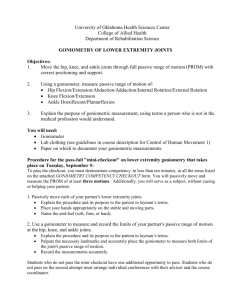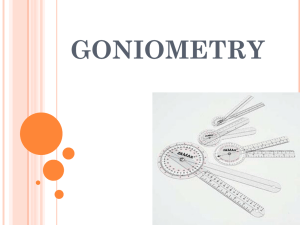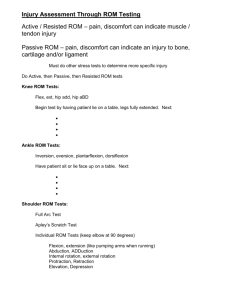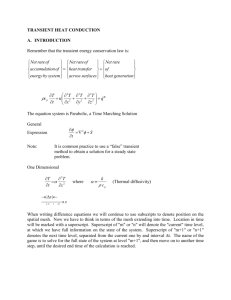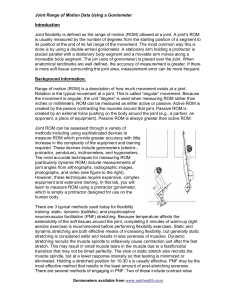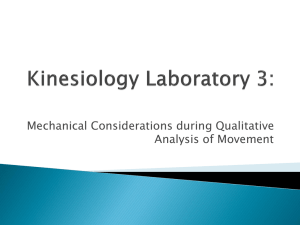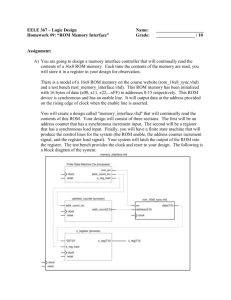Range of Motion (ROM) Booklet
advertisement
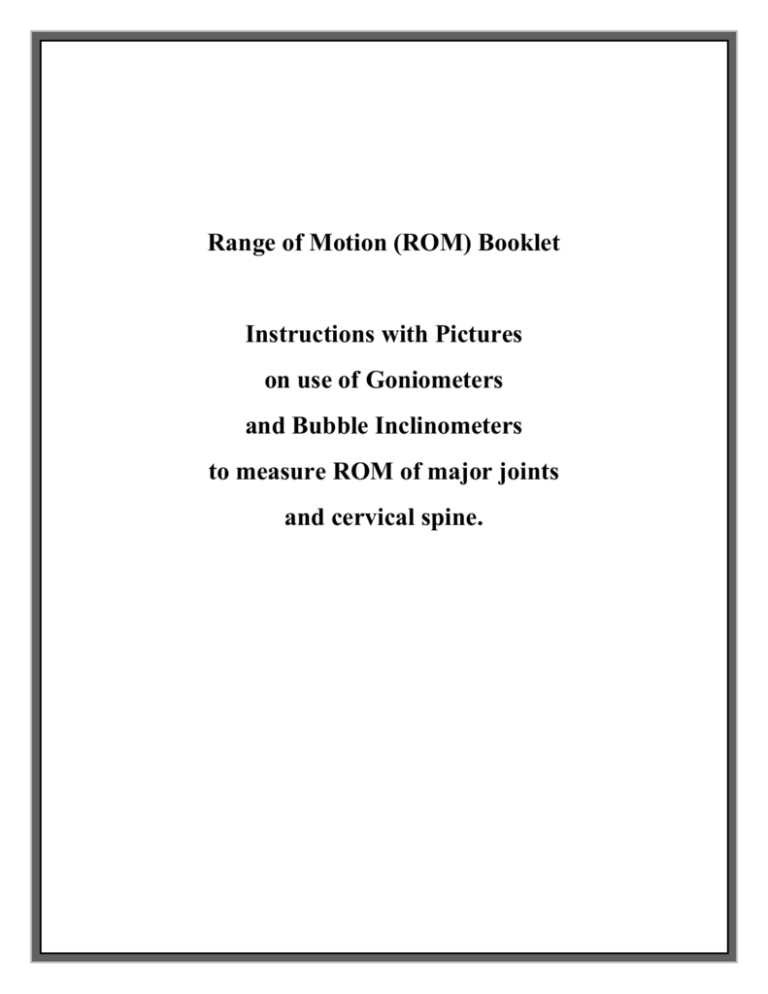
Range of Motion (ROM) Booklet Instructions with Pictures on use of Goniometers and Bubble Inclinometers to measure ROM of major joints and cervical spine. Measuring Range of Motion AOMA 2010 Table of Contents References Equipment ROM Values and Norms Use of Bubble Inclinometer Instruction set from Fabrication Enterprises Incorporated Measuring ROM Cervical Spine Flexion, Extension, Lateral Bend (side-bend), Rotation with Goniometer with Bubble Inclinometer Shoulder Flexion, Extension, Internal and External Rotation, Abduction with Goniometer Hip Flexion, Extension, Abduction, Adduction, External and Internal Rotation with Goniometer Knee Flexion, Extension with Goniometer ROM reference: Magee, D. 2006. Orthopedic Physical Assessment. 4th ed. Elsevier Sciences. Goniometer and Bubble inclinometers and patient position reference: Norkin C, White D. 2003. Measurement of Joint motion. A guide to Goniometry. 3rd edition. Philadelphia. F.A. Davis Company. Measuring Range of Motion AOMA 2010 References ROM References All ROM measurements are referenced from: Magee D. Orthopedic Physical Assessment. 4th edition. Elsevier Sciences. 2006 All the patient positions and goniometer positions are referenced Norkin C, White D. Measurement of Joint motion. A guide to Goniometry. 3rd edition. Philadelphia. F.A. Davis Company. 2003 Other References American Academy of Orthopaedic Surgeons. Joint Motion: Methods of Measuring and Recording. AAOS, Chicago, 1965. Cleland, Joshua. Orthopaedic Clinical Examination: An Evidence-Based Approach for Physical Therapists. 2005. Carlstadt, NJ: Icon Learning Systems. Dutton, Mark. Orthopaedic Examination, Evaluation and Intervention. 2004. New York: McGraw Hill. Rothstein, Jules M., Serge H. Roy, Steven L Wolf, David A. Scalzitti. The Rehabilitation Specialist’s Handbook, 3rd ed. 2005. Philadelphia: F.A. Davis Company. Bubble inclinometer instructions from: Fabrication Enterprises Incorporated PO Box 1500 White Plains, New York 10602 (USA) tel: 914-591-9300 fax: 914-591-4083 ROM reference: Magee, D. 2006. Orthopedic Physical Assessment. 4th ed. Elsevier Sciences. Goniometer and Bubble inclinometers and patient position reference: Norkin C, White D. 2003. Measurement of Joint motion. A guide to Goniometry. 3rd edition. Philadelphia. F.A. Davis Company. Measuring Range of Motion AOMA 2010 The goniometer is a standard device for measuring angles and is relatively inexpensive. Bubble inclinometers are gaining in popularity for ease of use, but are more expensive and lack research for its validity and reliability. Goniometers come in various sizes for use with different joints. Goniometer has three components. The circular or semi-circular base with degree markings is called the body. Goniometers also have two arms. The stationary arm is fixed to the body. The moving arm is moved in concert with the patient’s joint movement and points to the readings on the goniometer body . Bubble inclinometers have a circular tube partiallyfilled with a colored fluid that moves with motion, and is gravity dependent. It has a moveable circular dial with degree markings. Each measure device requires knowledge of placement and expected measurement. The measurement should include which device was used. Ideally, each time a patient is remeasured the same device type would be used. For left and right sided movements, both sides should be measured and compared. Before the use of the goniometer and the bubble inclinometer, a tape measure was used for certain range of motion measurements. It is still used for measuring torso girth, and well as diameter of limbs for leftright comparisons (for muscle wasting, edema, etc.). Use of tape measure for range of motion measurements is not included in this booklet. (Please refer to Measurement of Joint Motion by Cynthia C. Norkin for more details.) ROM reference: Magee, D. 2006. Orthopedic Physical Assessment. 4th ed. Elsevier Sciences. Goniometer and Bubble inclinometers and patient position reference: Norkin C, White D. 2003. Measurement of Joint motion. A guide to Goniometry. 3rd edition. Philadelphia. F.A. Davis Company. Measuring Range of Motion AOMA 2010 Range of Motion Measurement Values and Norms The ranges of motion measurements for different movements vary considerably in the literature. Range of motion values often decline with age without detriment to a person’s quality of life or ability to do activities of daily living (ADL). More important than which set of ROM values to use as criteria, consider the following: What does the ROM limitation have on the quality of the patient’s life? How does the ROM limitation affect general movements and ability to do tasks in the person's life (ADLs: Activities of Daily Lives)? How close is the patient's ROM to an expected full range of motion? How does a left-sided movement compare to a right-sided movement? What are the ROM measurements on the same patient over time, over the course of several treatments? It is recommended that measurements be taken at initial evaluation, and after every four to six weeks of treatment. The idea is that four to six weeks are the expected tissue healing time. Documentation ROM provides objective, reproducible outcome measurements. Documentation of ROM can help determine the effectiveness of treatment. It can promote continuous patient care between practitioners: this means that when a patient is seeing two different practitioners or interns for the same condition, such as shoulder pain, documented ROM can help them determine the progression of treatment. Either the shoulder is getting better or worse (or no change) through treatment. Proper ROM documentation needs to include date, joint measured, active or passive movement, types of ROM (flex, extend, etc.), testing position, equipment used, and the range measurement. Example: Cervical AROM (Active ROM) sitting with goni Flexion (Flex) 0-600 Extension(Ext) 0-450 Left Sidebend (LS) 0-450 Right Sidebend (RS) 0-450 Left Rotation (LR) 0-800 Right Sidebend (RS) 0-800 ROM reference: Magee, D. 2006. Orthopedic Physical Assessment. 4th ed. Elsevier Sciences. Goniometer and Bubble inclinometers and patient position reference: Norkin C, White D. 2003. Measurement of Joint motion. A guide to Goniometry. 3rd edition. Philadelphia. F.A. Davis Company. Measuring Range of Motion AOMA 2010 Measuring Neck Flexion with a Goniometer 1. With patient in a seated position, place the center of goniometer body over the external auditory meatus. 2. Align stationary arm perpendicular to the floor . 3. Align moving arm with nares. This is the Neutral or “zero” position. 4. Keeping stationary arm in perpendicular position, have patient bend the neck forward bringing the chin as close to chest as possible. Align moving arm with the nares. Read the angle. Normal ROM: 80-900 ROM reference: Magee, D. 2006. Orthopedic Physical Assessment. 4th ed. Elsevier Sciences. Goniometer and Bubble inclinometers and patient position reference: Norkin C, White D. 2003. Measurement of Joint motion. A guide to Goniometry. 3rd edition. Philadelphia. F.A. Davis Company. Measuring Range of Motion AOMA 2010 Measuring Neck Extension with a Goniometer 1. With patient in a seated position, place the center of goniometer body over external auditory meatus. 2. Align stationary arm perpendicular to the floor. 3. Align rotating arm with nares. This is the neutral or “zero” position. 4. Keeping stationary arm in perpendicular position, have patient extend neck backward to bringing the back of head as close to upper back as possible. Align moving arm with the nares. Read the angle. Normal ROM: 700 ROM reference: Magee, D. 2006. Orthopedic Physical Assessment. 4th ed. Elsevier Sciences. Goniometer and Bubble inclinometers and patient position reference: Norkin C, White D. 2003. Measurement of Joint motion. A guide to Goniometry. 3rd edition. Philadelphia. F.A. Davis Company. Measuring Range of Motion AOMA 2010 Measuring Neck Lateral Bend (Side Bend) with a Goniometer 1. With patient in a seated position, locate C7 spinous process. 2. Locate occipital protuberance. 3. Place the center of goniometer body over C7 and align stationary arm with the spinous processes of the thoracic vertebrae so that the arm is perpendicular to the floor. Align the moving arm in the opposite direction going straight up over the occipital protuberance. This is the “zero” position. 4. Stabilize the shoulder opposite of the bend. Have the patient do a lateral bend by bringing the ear as close to the top of the shoulder as possible without moving either shoulder. Align the moving arm with the occipital protuberance. Read the angle. Normal ROM: 20-450 Do both left and right sides and compare the readings. ROM reference: Magee, D. 2006. Orthopedic Physical Assessment. 4th ed. Elsevier Sciences. Goniometer and Bubble inclinometers and patient position reference: Norkin C, White D. 2003. Measurement of Joint motion. A guide to Goniometry. 3rd edition. Philadelphia. F.A. Davis Company. Measuring Range of Motion AOMA 2010 Measuring Neck Rotation with a Goniometer 1. With patient in a seated position, locate the vertex (~DU20) and the tip of the nose. 2. Place the center of the goniometer body over the vertex (at ~ Du20), with the stationary arm align with acromion process. The moving arm should be aligned with the tip of the nose. 3. Keep the stationary arm in the original position as the patient rotates to one side. Align the moving arm with the tip of the nose for the reading. Normal ROM: 70-900 Do both left and right sides and compare the readings. ROM reference: Magee, D. 2006. Orthopedic Physical Assessment. 4th ed. Elsevier Sciences. Goniometer and Bubble inclinometers and patient position reference: Norkin C, White D. 2003. Measurement of Joint motion. A guide to Goniometry. 3rd edition. Philadelphia. F.A. Davis Company. Measuring Range of Motion AOMA 2010 Measuring neck flexion with a bubble inclinometer 1. With patient in a seated position, place inclinometer on vertex of head. Move rotating dial so that the “0” / arrow aligns with the surface of the fluid. 2. Holding the inclinometer securely in a steady position, have patient bend the neck forward bringing the chin as close to chest as possible. Read the measure indicated by the level of the inclinometer fluid. Normal ROM: 80-900 Make sure the patient’s upper spine is stabilized during the flexion. A method to account for thoracic movement is to have a second inclinometer on T1 to measure any forward movement of the thorax. This measurement is subtracted from the above reading to obtain a more accurate ROM of the neck. ROM reference: Magee, D. 2006. Orthopedic Physical Assessment. 4th ed. Elsevier Sciences. Goniometer and Bubble inclinometers and patient position reference: Norkin C, White D. 2003. Measurement of Joint motion. A guide to Goniometry. 3rd edition. Philadelphia. F.A. Davis Company. Measuring Range of Motion AOMA 2010 Measuring neck extension with a bubble inclinometer 1. With patient in a seated position, place inclinometer on vertex of head. Move rotating dial so that the “0” / arrow aligns with the surface of the fluid. 2. Holding the inclinometer securely in a steady position, have patient extend neck backward to bringing the back of head as close to upper back as possible. Read the measure indicated by the level of the inclinometer fluid. Normal ROM: 700 Make sure the patient’s upper spine is stabilized during the flexion. A method to account for thoracic movement is to have a second inclinometer on T1 to measure any forward movement of the thorax. This measurement is subtracted from the above reading to obtain a more accurate ROM of the neck. ROM reference: Magee, D. 2006. Orthopedic Physical Assessment. 4th ed. Elsevier Sciences. Goniometer and Bubble inclinometers and patient position reference: Norkin C, White D. 2003. Measurement of Joint motion. A guide to Goniometry. 3rd edition. Philadelphia. F.A. Davis Company. Measuring Range of Motion AOMA 2010 Measuring neck lateral bend (side bend) with a bubble inclinometer 1. With patient in a seated position, place inclinometer on vertex of head. Move rotating dial so that the “0” / arrow aligns with the surface of the fluid. 2. Hold the inclinometer securely in a steady position and stabilize the shoulder opposite of the bend. Have the patient do a lateral bend by bringing the ear as close to the top of the shoulder as possible without moving either shoulder. Read the measure indicated by the level of the inclinometer fluid. Normal ROM: 20-450 Do both left and right sides and compare the readings. ROM reference: Magee, D. 2006. Orthopedic Physical Assessment. 4th ed. Elsevier Sciences. Goniometer and Bubble inclinometers and patient position reference: Norkin C, White D. 2003. Measurement of Joint motion. A guide to Goniometry. 3rd edition. Philadelphia. F.A. Davis Company. Measuring Range of Motion AOMA 2010 Measuring neck rotation with a bubble inclinometer 1. With patient in a supine position, place inclinometer on top of the forehead. Move rotating dial so that the “0” / arrow aligns with the surface of the fluid. 2. Hold the inclinometer securely in a steady position and have the patient rotate to one side. Read the measure indicated by the level of the inclinometer fluid. Normal ROM: 70-900 Do both left and right sides and compare the readings. ROM reference: Magee, D. 2006. Orthopedic Physical Assessment. 4th ed. Elsevier Sciences. Goniometer and Bubble inclinometers and patient position reference: Norkin C, White D. 2003. Measurement of Joint motion. A guide to Goniometry. 3rd edition. Philadelphia. F.A. Davis Company. Measuring Range of Motion AOMA 2010 Activities of Daily Living – Examples Flexion, abduction and external rotation are important for fixing hair! Extension and internal rotation is important hooking, unhooking bra straps, cleaning after bowel movement, and getting the wallet out of the back pocket! Compare left to right side movements. ROM reference: Magee, D. 2006. Orthopedic Physical Assessment. 4th ed. Elsevier Sciences. Goniometer and Bubble inclinometers and patient position reference: Norkin C, White D. 2003. Measurement of Joint motion. A guide to Goniometry. 3rd edition. Philadelphia. F.A. Davis Company. Measuring Range of Motion AOMA 2010 Measuring Shoulder Flexion with a Goniometer 1. Patient in supine position. Locate the humeral head and the lateral epicondyle of the humerus. 2. Locate the lateral mid-line of the truck. 3. Place the body of the goniometer over the humeral head. Align the stationary arm with the lateral mid-line of the truck. 4. Have patient flex shoulder by moving arm upward and backward as far as possible. Align moving arm with lateral epicondyle of humerus. Read the angle. Normal ROM: 160-1800 Do both left and right sides and compare the readings. ROM reference: Magee, D. 2006. Orthopedic Physical Assessment. 4th ed. Elsevier Sciences. Goniometer and Bubble inclinometers and patient position reference: Norkin C, White D. 2003. Measurement of Joint motion. A guide to Goniometry. 3rd edition. Philadelphia. F.A. Davis Company. Measuring Range of Motion AOMA 2010 Measuring Shoulder Extension with a Goniometer 1. Patient in prone position with patient’s head turned away from the testing arm. Locate the humeral head, the lateral epicondyle of humerus, and the mid-line of truck. 2. Place the center of the goniometer body over the humeral head. Align the stationary arm with the lateral mid-line of truck. 3. Have patient lift the arm backward as far as possible. Align moving arm with lateral epicondyle of humerus. Read the angle. Normal ROM: 50-600 Do both left and right sides and compare the readings. Measuring Shoulder External and Internal Rotation with a Goniometer ROM reference: Magee, D. 2006. Orthopedic Physical Assessment. 4th ed. Elsevier Sciences. Goniometer and Bubble inclinometers and patient position reference: Norkin C, White D. 2003. Measurement of Joint motion. A guide to Goniometry. 3rd edition. Philadelphia. F.A. Davis Company. Measuring Range of Motion AOMA 2010 1. Patient in supine position. Place a folded pillow case under the humerus to keep shoulder and elbow level. Elbow is bent at 900 angle and forearm is perpendicular to floor. Locate the olecranon process and the ulnar styloid process. 2. Place center of goniometer body over olecranon process and keep stationary arm perpendicular to floor. 3. For external rotation, have patient move the forearm upward towards the head. Align moving arm with ulnar styloid process. Read angle. Normal ROM: 80-900 Do both left and right sides and compare the readings. 4. For internal rotation, have patient move the forearm downward towards the feet. Align moving arm with ulnar styloid process. Read angle. Normal ROM: 60-1000 Do both left and right sides and compare the readings. ROM reference: Magee, D. 2006. Orthopedic Physical Assessment. 4th ed. Elsevier Sciences. Goniometer and Bubble inclinometers and patient position reference: Norkin C, White D. 2003. Measurement of Joint motion. A guide to Goniometry. 3rd edition. Philadelphia. F.A. Davis Company. Measuring Range of Motion AOMA 2010 Measuring Shoulder Abduction with a Goniometer 1. Patient in supine position. Locate the anterior aspect of the acromion process and the sternum. Place the center of goniometer body over anterior aspect of acromion process and align stationary arms with sternum. 2. Have patient abduct the arm, moving laterally outward. Here the arm is abducted about half way; have patient turn the palm up and continue the movement. 3. When patient has abducted as far as possible to the ear, align the moving arm with the anterior mid-line of the humerus. Read the angle. Normal ROM: 170-1800 ROM reference: Magee, D. 2006. Orthopedic Physical Assessment. 4th ed. Elsevier Sciences. Goniometer and Bubble inclinometers and patient position reference: Norkin C, White D. 2003. Measurement of Joint motion. A guide to Goniometry. 3rd edition. Philadelphia. F.A. Davis Company. Measuring Range of Motion AOMA 2010 Measuring Hip Flexion with a Goniometer 5. Patient in supine position. Locate the greater trochanter of the femur and the lateral epicondyle of femur. 6. Place the center of the goniometer body over the greater trochanter. Align the stationary arm with the lateral mid-line of the pelvis. Align the moving arm with lateral epicondyle of femur. 7. Stabilize pelvis and have patient flex hip bringing thigh close to the trunk with knee bent. Align moving arm with lateral epicondyle of femur. Read the angle. Normal ROM: 110-1200 Do both left and right sides and compare the readings. ROM reference: Magee, D. 2006. Orthopedic Physical Assessment. 4th ed. Elsevier Sciences. Goniometer and Bubble inclinometers and patient position reference: Norkin C, White D. 2003. Measurement of Joint motion. A guide to Goniometry. 3rd edition. Philadelphia. F.A. Davis Company. Measuring Range of Motion AOMA 2010 Measuring Hip Extension with a Goniometer 4. Patient in prone position. Locate the greater trochanter of the femur and the lateral epicondyle of the femur. 5. Place the center of goniometer body over the greater trochanter. Align the stationary arm with the lateral mid-line of the pelvis. 6. Stabilize pelvis and have patient extend hip by lifting the leg upward. Align moving arm with lateral epicondyle of femur. Read the angle. Normal ROM: 10-150 Do both left and right sides and compare the readings. ROM reference: Magee, D. 2006. Orthopedic Physical Assessment. 4th ed. Elsevier Sciences. Goniometer and Bubble inclinometers and patient position reference: Norkin C, White D. 2003. Measurement of Joint motion. A guide to Goniometry. 3rd edition. Philadelphia. F.A. Davis Company. Measuring Range of Motion AOMA 2010 Measuring Hip Abduction with a Goniometer 4. Patient in supine position, with toes pointing up (no rotation). Locate the anterior superior iliac spine (ASIS) on both sides and the midline of the femur. Place the center of goniometer body over the ASIS of the side being measured and point the stationary arm to the opposite ASIS. Align the moving arm with the with the midline of the femur, using the midline of the patella for reference. 5. Stabilize pelvis and have patient abduct the leg, moving laterally outward. Read the angle. Normal ROM: 30-500 Do both left and right sides and compare the readings. ROM reference: Magee, D. 2006. Orthopedic Physical Assessment. 4th ed. Elsevier Sciences. Goniometer and Bubble inclinometers and patient position reference: Norkin C, White D. 2003. Measurement of Joint motion. A guide to Goniometry. 3rd edition. Philadelphia. F.A. Davis Company. Measuring Range of Motion AOMA 2010 Measuring Hip Adduction with a Goniometer 1. Patient in supine position, with toes pointing up (no rotation). Have patient move the leg of the non-testing side laterally out of the way. Locate the anterior superior iliac spine (ASIS) on both sides and the midline of the femur, using the midline of the patella for reference. Place the center of goniometer body over the ASIS of the side being measured and point the stationary arm to the opposite ASIS. Align the moving arm with the with the midline of the femur, using the midline of the patellar for reference. 2. Stabilize pelvis and have patient adduct the leg, moving it medially inward. Read the angle. Normal ROM: 0-300 Do both left and right sides and compare the readings. ROM reference: Magee, D. 2006. Orthopedic Physical Assessment. 4th ed. Elsevier Sciences. Goniometer and Bubble inclinometers and patient position reference: Norkin C, White D. 2003. Measurement of Joint motion. A guide to Goniometry. 3rd edition. Philadelphia. F.A. Davis Company. Measuring Range of Motion AOMA 2010 Measuring Hip External and Internal Rotation with a Goniometer 5. Patient in seated position with lower legs dangling freely(short sit), perpendicular to floor. Locate the anterior aspect of the patella and the midline of the tibia. 6. Place the center of goniometer body over the center of the patella and keep stationary arm of goniometer perpendicular to floor. 7. For external rotation, stabilize distal femur head with one hand and distal fibular with another. Guide the patient to move the lower leg medially as much as he/she can without moving the hip. Stationary arm is perpendicular to the floor: align the moving arm with the midline of tibia. Read angle. Normal ROM: 40-60 Do both left and right sides and compare the readings. 8. For internal rotation, stabilize distal femur head with one hand and distal fibular with another. Guide the patient to move the lower leg laterally as much as he/she can without moving the hip. Stationary arm is perpendicular to the floor: align the moving arm with the midline of tibia. Read angle. Normal ROM: 30-40 Do both left and right sides and compare the readings. ROM reference: Magee, D. 2006. Orthopedic Physical Assessment. 4th ed. Elsevier Sciences. Goniometer and Bubble inclinometers and patient position reference: Norkin C, White D. 2003. Measurement of Joint motion. A guide to Goniometry. 3rd edition. Philadelphia. F.A. Davis Company. Measuring Range of Motion AOMA 2010 Measuring Knee Flexion with a Goniometer 1. Patient is supine. Locate greater trochanter and lateral epicondyle of the femur. Place the center of goniometer body on lateral epicondyle of femur. Align stationary arm with midline of femur, using greater trochanter for reference. Locate the lateral maleolus. 2. Have patient flex knee. Align moving arm with the lateral maleolus. Read the angle. Normal ROM: 1350 ROM reference: Magee, D. 2006. Orthopedic Physical Assessment. 4th ed. Elsevier Sciences. Goniometer and Bubble inclinometers and patient position reference: Norkin C, White D. 2003. Measurement of Joint motion. A guide to Goniometry. 3rd edition. Philadelphia. F.A. Davis Company.
